We are meeting at 611 at 10:30 and at the Whitney Musuem at 11:30
Check this link for the cutting edge art forms in the New York Art world
Museum of Natural History- Kate Jackson
Museum of Natural History
Horse Exhibit
This exhibit is devoted solely to (you guessed it) the horse. It starts off with the horse’s beginnings, its ancestors and how it evolved into the horse known today. It makes note of the fact that no true wild horses exist today-the American “wild horse,” or mustang, is really just the descendants of other equines shipped over here, mainly by the Spanish. They’re not truly wild, in other words. The closest modern-day equivalent to wild horses is the Przewalski horse, an Asiatic living fossil. The rest of the beginning of the exhibit is mostly statistics and facts, although they do make interesting mention of zebras. Apparently, zebras are territorial (unlike horses), so they can’t share turnout. They’ll fight. Also, zebras are very aggressive. More zoo handlers are injured by zebras than by tigers, and zebra injuries nearly equal that of all other zoo animal-inflicted as a whole.
Before horses were transportation, they were food. Cave paintings feature the horse more than any other animal. These paintings closely resemble the modern-day Przewalski horse. Apparently they were quite tasty. The exhibit traces the gradual use of horses for transportation, from pulling sledges to being ridden and harnessed to wagons/chariots. Unlike most domesticated animals, the horse’s bone structure didn’t change rapidly after domestication, making it hard for archeologists to tell the difference between wild and tame animals. Horses and other herd animals are easy to domesticate, as they naturally establish a pack hierarchy and will submit to authority, as opposed to lone or pair animals that don’t bend to a lower ranking. Horses can be trained to do many things unnatural to them, like carry riders, pull loads, and jump fences. Training mostly takes cues that horses respond to naturally, and applies them to specific ends. Horses don’t instinctively want to jump over things. In the wild, it’s a good way to break a leg. However, the urge to remain with the herd is much stronger. To teach young horses to jump, first we would lay down ground poles, or cavelettis. It’s not a big deal to walk over them for most young animals. Gradually, the bar is raised. To encourage reluctant horses to cross poles and low fences, a “rabbit” is often used-an older or more experienced horse that the young horse can follow. Techniques similar to this are used to teach young horses to lead, or to follow humans when “leashed.” Foals are walked alongside their dams, with a person walking beside them with a lead. The horse will come to accept the person as a surrogate mother to follow, which is why a small and relatively weak person can lead about a much bigger animal.
Horses were used extensively in warfare. They were used in Japan by the samurai, and in Europe by mounted knights. Samurai were expected to be able to accurately fire their bows from horseback at a gallop, and it has evolved into a sport practiced to this day. Knights often had 3 horses at their disposal: destriers (large horses that carried heavy plate armor) coursers (more agile horses for running battles) and rounceys (placid beasts used for travel). Mongols carried off daring raids from the backs of their hardy ponies, and horses figure into the cowboy and indian myths of America. Even in modern times, US Special Forces will use horses for transportation in terrain unsuitable for vehicles. During World War II, horses were often used in support capacities, pulling ambulance wagons and such. They were fitted with their own special gas masks, which (unlike human masks) left the eyes unprotected.
In many cultures, horses were a sign of wealth. They were sometimes revered as holy, but I’m not sure how people reconciled riding their god about. Until fairly recently in human history, riding was the fastest form of transportation, and helped shape expansion. Horses are also terrific athletes, with many sports focussed around them: dressage, polo, cross country, show jumping, racing, polo, trick riding, rodeo events, barrel racing, pole bending, gymkhana events, and reining. The exhibit featured a looping video of famous riding events, including the Triple Crown, the 2000 Olympics, and the Marshall & Sterling finals. I enjoyed the last, as I know and competed against the girl shown in the video- it was taken from the 2007 Marshall & Sterling finals, and I whipped her soundly in points and at the show.
Riding in all its forms is an inherently dangerous sport, for both riders and horses. Sport Illustrated states that being a jockey on flat races is the most dangerous athletic profession. For horses, with their delicate legs, many sports such as jumping and racing are extremely strenuous. Race track injuries are rampant, as evidenced by Barbaro’s broken leg during one of the past Triple Crown races.

Image of a samurai’s saddle. The stirrups are different than those of most modern saddles in the you don’t put your foot through it. It’s a smart design, as the stirrups used today for most saddles are apt to trap your foot if you fall. A horse once flipped over on me, and my leg became tangled in the stirrups. I was dragged around the ring for a good five minutes before the leathers broke. It may not sound long, but it was an eternity for me at the time.
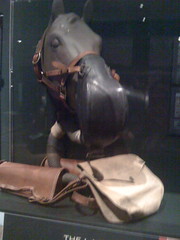
Picture of the gas mask horses were outfitted for during WWII. It was probably motivated less by altruism and more by the fact that a horse going nuts off nerve gas and dying (to leave an unwieldy corpse) would be inconvenient to say the least.
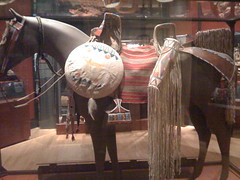
Gear a wealthy Sioux woman would have decked her horse out in. It’s hard to take it seriously, as the way it’s designed would have made it useless for anything other than riding-the girth for the blankets can’t be tightened enough to hold the padding secure, much less save a rider if she attempted to use the ornately beaded stirrups. It’s flashy though.

Heather Jansch driftwood sculpture of a horse. It’s impressive, and life-size. Horses are elegant in form, and make for great art. Much of the gear used for riding is art in for its own sake. Western saddles often feature ornate silver decoration, along with the gear of spanish vaqueros. Bits were designed with elaborate shanks, and the bridle/saddle leather was embossed and worked into beautiful designs. It ties into the discussion of what is art-although these pieces have a clear utility and purpose, great skill undoubtedly went into making them, and they’re beautiful. The photos don’t do justice to the exhibit, but the guards were frowning on photography.

Cave painting, Lascaux Horse, The Granger Collection, New York

Przewalski horse (modern day) [http://library.thinkquest.org/C0114235/geography_PROTECTED_GOBI.htm]
Look familiar?
Drawings By New York- Kate Jackson
The New-York Historical Society
Drawn By New York Exhibit
An exhibit of art by New York artists. Some of the art features scenes from New York, while others depict different views. The New-York Historical Society is a more intimate venue for these paintings, and is entirely less crowded than the other, more popular museums.
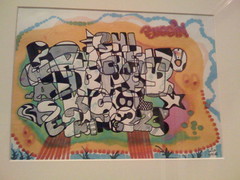

Tracy 182- Graffiti artist, drew inspiration from impressionism, inspired many young artists to pick up the spray can. Images of his “buggin” and “tracy 182″ are done in wildstyle. Originally from the Bronx, he was part of the conception of graffiti. His art is said to resemble the work of German Expressionist Paul Klee, Abstract Expressionist Franz Kline, and Islamic calligraphy. This raises issues on the ethical, emotional, and artists aspects inherent in a bold art that is prominently displayed on other people’s property.



Eve Aschhiem- Strange Water 1999-200, Water III 1996, Water VII 1997- belongs to Aschhiem’s Water Series, a collection of 200 drawings of the Hudson River. Aschhiem obsessively studied water patterns, bringing the Hudson School of American Art into the modern age. Her paintings have no color, yet evoke the sensation and memory of water with the play of light between dark and white, creating unsettled and fluid images. Her work also reflects the words of Heraclitus, in that one cannot step into the same water twice. Aschhiem’s drawings? sketches? paintings? clearly show the wisdom of these words: the water she draws from her studio (repeatedly) never looks the same. There’s something about her images that captures the eye, something undoubtedly liquid despite her monotone color scheme.
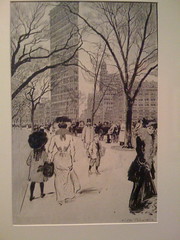
Victor Semon Perard- The Flatiron Building: Fifth Avenue and Madison Square, New York, 1907: coming on the heels of Hassam’s New York and the different between imitation and creation, this black and white sketch of the Flatiron Building caught my eye. Deceptively simple, yet eye-catching, this pen & ink sketch shows a woman from behind, dressed in period fashion, walking towards the uniquely-shaped Flatiron Building in the background. Various other bystanders function in the sketch, but the eye is immediately drawn towards the women, and the building that echoes her upright posture. It is possible that the artist sought to contrast her curves and femininity against the phallic symbol of the building, and if so, he was successful.
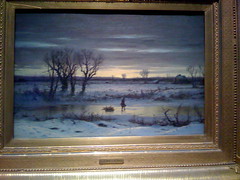
George Henry Boughton: Winter Twilight Near Albany, New York, 1858: icy and desolate, this picture immediately stood out amongst its warmly painted and pastoral fellows. Although pastoral itself in theme, the painting shows a bleak and harsh winter landscape, with scrubby and barren trees, a frozen-over creek, and a little boy dragging firewood along in an overburdened sled. The scene is forbidding; the low-hanging and bruised clouds threaten more snow (undoubtedly why the boy is stocking up on wood). What drew me to this picture is that it doesn’t show the unadorned natural charm of winter, or the rosy picture man would make of it-it shows a single human silhouetted against the dying sun in a dead and frozen waste, and the harsh beauty within it.

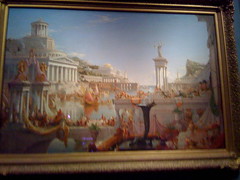
 Thomas Cole: Empire Series: in these three large canvasses, Cole depicts the rise and fall of an Empire. Apparently it was originally created as a cautionary tale for those who would build America into an empire. The first two paintings are a mishmash of great Empires, poorly combined and cluttered despite the skill that went into making them. The last canvas, showing nature’s reclamation and purification of the Empire’s corrupted remains, is striking-the decaying marble edifices, slowly being overgrown with moss and vines, are a warning to how fragile society is, and a cautionary tale for any would-be Caesars.
Thomas Cole: Empire Series: in these three large canvasses, Cole depicts the rise and fall of an Empire. Apparently it was originally created as a cautionary tale for those who would build America into an empire. The first two paintings are a mishmash of great Empires, poorly combined and cluttered despite the skill that went into making them. The last canvas, showing nature’s reclamation and purification of the Empire’s corrupted remains, is striking-the decaying marble edifices, slowly being overgrown with moss and vines, are a warning to how fragile society is, and a cautionary tale for any would-be Caesars.
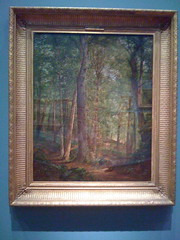
William Trost Richards: June Woods (Germantown), 1864: set in a gallery full of artificially contrived and composed landscapes, the wild, unplanned tangle of Richards’ June Woods is a refreshing and captivating break. Torn between the false landscapes of the Hudson School and critic John Ruskin’s call for absolute artistic fidelity, Richards struck a balance, painting nature, but as he saw it, not as how it was expected to be presented. The scene is a confusion of foliage and undergrowth, riven with winding paths probably made by the hooves of deer. The scene is infused with light and warm, sunlight filtering through the trees above.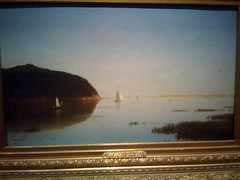
John Frederick Kensett: Shrewsbury River, New Jersey, 1859: a pastoral and planned landscape, this painting shows a panoramic view of the Shrewsbury River. The marshy expanse of water is dotted with the billowing canvas of sailboats, and the only delineation between sky and river is the shore and a frosting of golden reeds across the horizon of the water. Although true to the Hudson School’s depiction of idealized views, this painting isn’t too far from the true, and has a resonance and light to it.
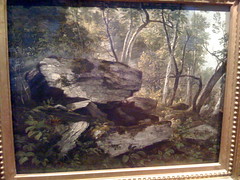
Thomas Hiram Hotchkiss: Catskill Mountains, New York, 1858: this canvas depicts a lifelike outcropping of stone surrounded by saplings and young forest growth. It is a more naturalistic and unplanned depiction of a landscape then typical of the Hudson School artists, which is probably why it’s more interesting-the jumble of rocks and stones create a more intriguing image than that of a staged pastoral scene.
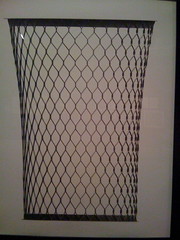
Edward Andrew Zega, Bernd H. Dams: Wire Trash Basket, 2003: Zega and Dams take something as utilitarian as one of the trash baskets common throughout Central Park, and make viewers look at it in a new light. Seen without the distracting back half of the basket, their life-size pen and charcoal drawing pays homage to the unexpected beauty of the ordinary. Their drawing was produced as part of an exhibit celebrating Central Park’s 150th birthday. The baskets themselves are manufactured by Corcraft Products of the New York State Department of Correctional services, a.k.a. New York State’s female inmates. The cans themselves will slowly be replaced. Despite their beauty, they are less than functional and easily crushable. Zega and Dams take a moment to remind New Yorkers to appreciate their trash receptacles before they disappear.
If any of the photos don’t work, they’re also on a Flickr account under katej0530@yahoo.com [http://www.flickr.com/people/32380076@N04/]
Union Square 2
I chose to do Hassam’s “Union Square 2” as my recreation picture but unfortunately I found many obstacles in trying to take the picture. Obviously Hassam’s picture was taken sometime in the fall as much of the foliage has fallen or is pigmented yellow, on the other hand in part due to global warming, the trees in Union Square today are still in full bloom. Additionally it seems that Hassam was atop a building when he painted this picture owing to the fact that all on sees of the park is the upper left hand side (and he couldn’t have been suspended in the middle of the park while he painted this). I was able to get as high as the 6th floor in the Filenes department store in order to take this picture but I have a feeling that he was on the very top of the building as seen by the angle of the ground in relation to the road. Additionally the dense foliage made it hard for me to see the intersecting roads so I had to use Google Maps to verify that Broadway turns on to 16th street t the angle displayed in Hassam’s painting. As for the positioning of the picture, I used the tall buildings in the background as a point of reference since they were there in the Hassam painting as well. Overall, from looking at everyone else’s comparisons I feel that New York was a much more interesting place at the turn of the century. Although that may have been because Hassam was a good artist.
The Brooklyn Bridge by Jin Woo Chung
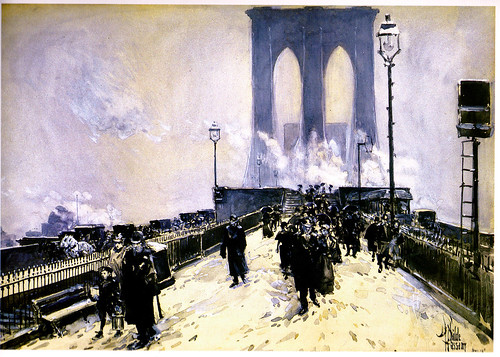
Above are two pictures of New York’s great tourist attraction, the Brooklyn Bridge. Considered an amazing feat of engineering during its times, the Bridge is depicted in Hassam’s painting not too long after its construction. Being an impressionist, Hassam depicts the Bridge as a huge, foreboding monolith in the back in the cold day as men, women and children make their way from it. The vanishing point is obvious as the linear perspectives centers on the bridge itself. The eerie smoke and hazy outlook gives the picture an ephemeral appearance.
In contrast to Hassam’s painting stands the good ol’ photo I took last week. Unlike Hassam’s, the Bridge here looks inviting and social, as people stand around it to talk or people just jog along it for some exercise. In the background can be seen the Brooklyn skyline, illustrating the modernity of the setting. The vanishing point is once again centered on the bridge and is the visual, realistic snapshot of the actual bridge.
Both these pictures showcase the Brooklyn Bridge, but Hassan’s makes his depiction of it quite cold and distant, while my photo of it shows it as a nice, inviting place for tourists around the world to gather and enjoy the site. Oh my! How New York has changed, hurry for gentrification and commercial tourism!!!
The Brooklyn Bridge - Alexander Schinis
Bridges — while New York City has many of them, the Brooklyn Bridge stands out from amongst them as an almost iconic symbol of the City. Above are seen two different pictures of the bridge, the first as it is depcited by artist Childe Hassam and the following being a picture of the actual modern day bridge. Both representations were produced from nearly the same viewpoint, and we can see that both bridges are nearly identical, with a few exceptions.
As seen in Hassam’s painting, the Bridge itself is more simple, yet more austere, than the modern bridge. It seems to loom in the background, wreathed in fog, appearing to be simple, powerful, and even cold. Hassam captured, too, the hustle and bustle of the bridge crossing folk, but as we can see, he gave them no faces and did not fill them with color; rather, we see the forms of people, somewhat indistinct, passing onward to their unknown destinations. The artist seems to be making a statement about the nature of the city that the bridge is located in.
Conversely, in the modern photograph, we see the bridge bathed in sunlight on a beautiful sunny day. There is foot traffic on the bridge, but the faces are clearly shown, and the people in the picture are wearing color as opposed to the black and gray of Hassam’s painting. The viewer can see some clear discrepancies between the two.
What can be inferred from this? To me, it seems clear: New York City has changed since Hassam’s time, from a rather grim, uninviting city to what many consider to be the very capitol of the world itself.
John Adams & Dvorak - Joel Kaplan
John Adams and Dvorak represent the two poles of musical composition that can be heard in music halls today. John Adams’ style of music involves minimalist influences, whereas Dvorak composed in the 19th century and was influenced by the Romantics and Classicals.
The similarities between the two composers relate to the emphasis each placed on their own experiences and cultures with regard to their musical creations. John Adams spoke about his interest in creating an American canon that referenced specifically American history and culture. Dvorak incorporated folk melodies and songs from the Czech republic in his music.
These events relate to our topic because of the distinctive stylistic choices made by each composer (minimalism/American cultural influences and folk music) and the awareness of the importance of style and originality in art.
Estrogen-ius!
I did not make it to the Philharmonic concert on Friday so I’m supplementing my absence with this commentary on a theater festival i attended. I went to a little place on MacDougal and 8th Street and walked into a haven of stereotypical liberalacci bohemians. The festival was called Estrogenius, a feminist off off broadway showing of 5 plays. It ranged from a couple that just so happens to be con artists, a mother and child ages 90ish and 50ish, and the climactic play was a couple moving to a new neighborhood that demands them to sacrifice their first born child to a local malevolent god named Sog Thothoth. Its hard to pronounce. It was a good show and brought out some interesting themes. The most interesting of which was the old mother in the second play i mentioned that had to deal with being a housewife her whole life and now too old to remarry or even do anything romantic she must find a meaning to life after her husbands death.
It was good.
Kenn Duncan’s Fabulous Photography of the 1970s!
Now on exhibit at the NYPL for the Performing Arts:
Focus on the ’70s: The Fabulous Photography of Kenn Duncan
A.I.R. INAUGURATES NEW GALLERY SPACE
Check here for details!







